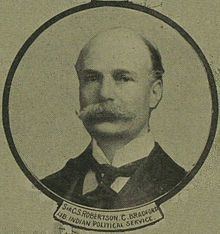Name George Robertson Role Author | Died January 1, 1916 | |
 | ||
Books The Kafirs of the Hindu-Kush, Chitral: The Story of a Minor Siege, A history of the Stromness golf courses, Kafiristan | ||
Sir George Scott Robertson, KCSI (22 October 1852 – 1 January 1916) was a British soldier, author, and administrator who was best known for his arduous journey to the remote and rugged region of Kafiristan in what is now northeastern Afghanistan and for his overall command of British Empire forces during the Siege of Chitral. He chronicled his Kafiristan experience in the book The Kafirs of the Hindu-Kush. Some have suggested that Robertson's year-long expedition and subsequent book (originally published in 1896) provided background and inspiration for Rudyard Kipling's short story "The Man Who Would Be King". However, Kipling's work was originally published in 1888, predating Robertson's travels to the region.
Contents
Travels to Kafiristan
Robertson was born in London, England, and received his education at the Westminster Hospital Medical School (now Chelsea and Westminster Hospital, London). In 1878 he entered the Indian Medical Service and served throughout the Second Anglo-Afghan War of 1878-80. In 1888, he was attached to the Indian Foreign Office and assigned as agency surgeon in Gilgit, in northern India, now Pakistan. According to his book it was around this time, during the war and while in Gilgit, that Robertson became interested in the land and way of life of the Kafir people. He asked the Government of India for permission to journey to Kafiristan, and by October 1889 was on his way, departing from Chitral in what is now northwest Pakistan in the company of several Kafir headmen of the Kam tribe. His journey lasted just over a year, ending in 1891, and providing Robertson with first-hand experience of what to him were the strange customs and colorful people of Kafiristan.
He was made a Companion of the Order of the Star of India in 1892.
Siege of Chitral
In 1893, after his travels in Kafiristan, Surgeon Major Robertson was re-assigned to the then-independent State of Chitral, this time as a political agent. In 1895 he brought a force of around 400 soldiers, under the direct command of Captain Charles Vere Ferrers Townshend, from Gilgit to oversee the transfer of power in Chitral following the death of its ruler, Aman ul-Mulk. After his arrival, Robertson engaged in a series of complex political and military maneuvers, during which hostility from local tribesmen led to his forces to move into Chitral Fort for protection. The six-week siege that followed included an unsuccessful sortie on 3 March 1895, when the British led forces took heavy losses. The siege was raised on 19 April when a relief force, under Colonel Kelly, arrived and dispersed the armed tribesmen. For his service during the famous siege Robertson was made a Knight Commander of the Order of the Star of India and appointed British agent in Gilgit. He who took the important decision of installing and recognising Shuja ul-Mulk as the provisional Mehtar of Chitral, subject to approval of the Government. He later wrote a book by the title Chitral; the Story of a Minor Siege recounting the intense and dramatic events in Chitral.
Later years
Robertson continued in the Indian Service until his retirement in 1899. He then returned to England where he made an unsuccessful bid for political office as a Liberal party candidate in Stirlingshire at the 1900 general election, but later was elected in Central Bradford in 1906. He held his seat in the House of Commons until his death on New Year's Day, 1916.
The Kafirs of the Hindu-Kush
This detailed account of Robertson's tour throughout Kafiristan was originally published in London in 1896 by Lawrence & Bullen, LTD. Although its descriptions of the kafirs of the Hindukush are written in an outdated and colonial (and, from the perspective of modern sensibilities, discriminatory) style, it also contains some of the only accounts of the region from that time period. The book is accompanied by illustrations by A.D. McCormic and was dedicated to Robertson's wife.
